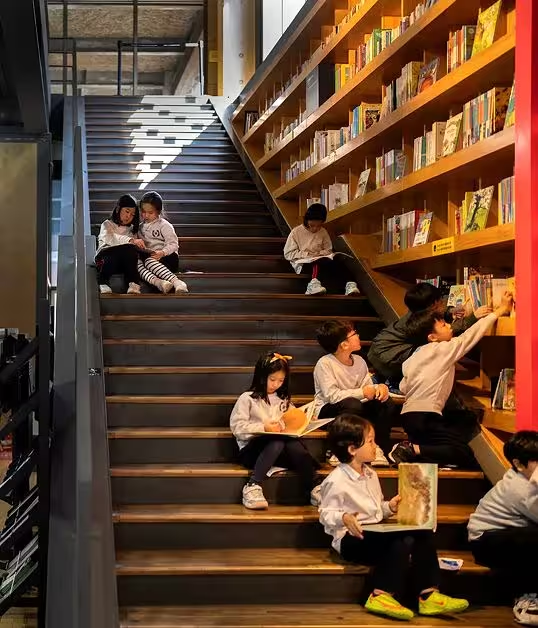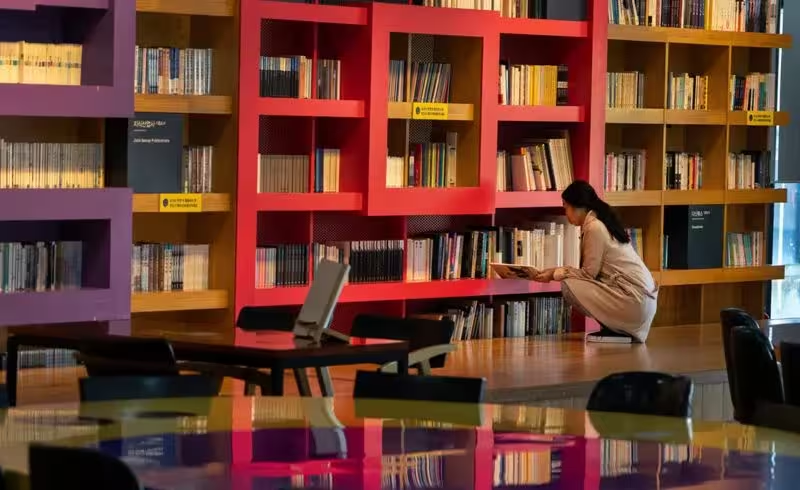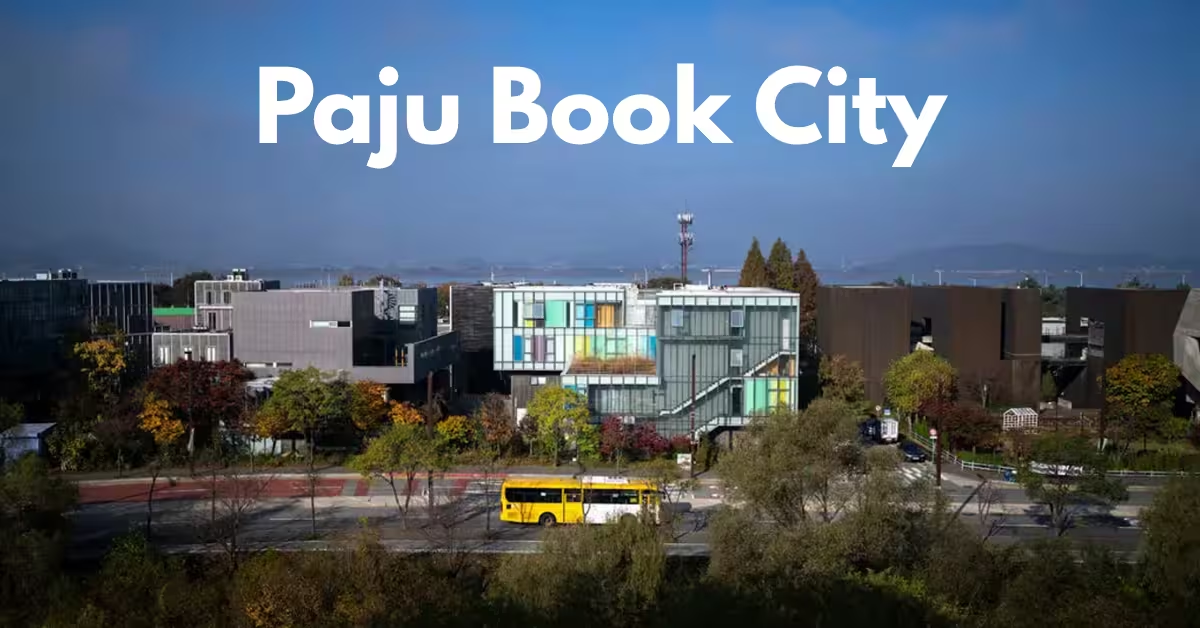About 22 miles (roughly 35 kilometers) northwest of central Seoul, the satellite city of Paju moves to a quieter rhythm. The air is cleaner, traffic thins, and the soundtrack of daily life includes the shuffling of pages, not just the shuffle of feet. Here, a purpose-built district called Paju Book City gathers nearly everything required to make a book—from the earliest editorial conversations to binding, distribution, exhibitions, and celebration.
With around 900 book-related businesses clustered across a thoughtfully planned urban campus, Paju offers something rare in our hyper-digital age: a place where print culture is both industry and inspiration.
What follows is a deep look at how Paju became a national hub for publishing, the experiences travelers can expect, and what its success reveals about the future of books in a digital world.
Table of Contents
Why Paju Book City exists
Paju Book City emerged from a late-20th-century modernization effort to consolidate South Korea’s previously scattered publishing sector. The government green-lit the project after nearly a decade of planning, and the hub officially opened in 1998. The logic was simple but powerful: put publishers, printers, designers, distributors, museums, and cultural venues in one place to increase efficiency, foster creativity, and showcase books as a living cultural asset.
The results speak for themselves. South Korea’s book market remains robust, with over 115 million books sold nationwide in a recent year, and Paju functions as both an economic engine and an open invitation to the reading public. The district’s mission—“to actively support culture and arts based on books”—is made visible in architecture, programming, and the day-to-day life of the campus.
A campus built around the book
Paju Book City isn’t a single building. It’s an urban design statement. Walking its streets, you pass low-rise and mid-rise buildings that house every step of the bookmaking process. You might see:
- Printing houses where offset presses run with rhythmic precision.
- Design studios finessing covers and typography.
- Distribution and logistics companies preparing shipments to bookstores and libraries nationwide.
- Cafés and reading nooks designed less for quick coffee runs and more for lingering with a novel or picture book.
Even the showpiece architecture carries a narrative. Photopia, a striking, curved, purple-hued building, serves as a photography production and processing studio. Dulnyouk, a well-known publisher, works from a dramatic, geometric headquarters that looks more like a sci-fi set piece than a typical office. These aren’t just workplaces—they’re landmarks that telegraph the district’s creative identity.
The Asia Publication Culture & Information Center
At the center of everything is the Asia Publication Culture & Information Center, a five-story complex with an education facility, event hall, and exhibition space. It’s the social and professional nucleus where industry pros convene—and it welcomes the public, too, drawing around 10,000 visitors annually.
Inside, the star attraction is the Forest of Wisdom. Imagine floor-to-ceiling shelves—some soaring more than 25 feet high—loaded with tens of thousands of titles, with even more kept in storage.

You can’t check the books out, but you can browse freely and read in shared spaces, which turns the library into an urban living room for families, students, and travelers. The center even includes a hotel for overnight stays, so book lovers can literally drift off surrounded by spines and stories.
A hands-on museum for the craft of printing
While Paju looks toward the future, it also preserves the past. Adjacent to the center sits the Book City Letterpress Museum, a working tribute to typography and traditional printing. Its collection includes 35 million metal character blocks, along with presses, type cases, and tools that let visitors see—and sometimes try—the analog craft behind modern publishing.
Remarkably, the museum also houses a copy of the world’s oldest extant book printed with movable metal type (dating to 1377, during the Goryeo Dynasty), a reminder that Korea’s printing innovations run deep.

For students and educators, the museum and center provide hands-on lessons: letterpress demonstrations, guided lab sessions about the modern production workflow, and exhibitions that connect design choices to the reading experience. On any given day, you’ll spot school groups—from elementary students sharing picture books on a broad staircase to high schoolers learning color workflows and prepress basics.
Festivals, typewriters, and the joy of analog
Paju Book City is not a static monument; it is a vibrant, evolving community. Its role in education is significant. On any given day, the sounds of first graders in matching uniforms, reading quietly on a flight of stairs, mingle with the focused energy of high school juniors and seniors participating in hands-on workshops about printing and publishing. These experiences plant the seeds for the next generation of publishers, designers, and readers.
Every fall, the city comes alive for its annual literary festival, now in its second decade. The event is a euphoric celebration, bringing together local authors, artists, and book lovers. The festival lineup typically includes art exhibitions, live music, and a unique typing competition where the clatter of typewriters echoes as contestants are judged on speed and accuracy. It is a poignant reminder of the physical connection between the writer, the machine, and the page.
The central question that Paju Book City confronts is one that resonates globally: In a digital world, what is the future of the physical book? The managers and residents of Paju have a steadfast belief. “Even as the world becomes more digital, the charm of books is never lost on readers,” asserts Lee Sang-yeon. “Those who love to read books will always come back.”
Paju’s success is a powerful argument for the tangibility, durability, and deep sensory pleasure of the printed object. It demonstrates that books are not merely vessels for information but artifacts of cultural and emotional significance. By creating a holistic environment that celebrates every facet of book culture—from its historical roots and modern manufacturing to its ultimate consumption and enjoyment—Paju Book City has future-proofed itself. It is a sustainable ecosystem for the mind and soul.
Every fall, Paju Book City throws a book festival that gathers local authors, illustrators, publishers, and readers. Programming shifts year to year, but you can count on art exhibitions, live performances, and a celebration of craft. Among the most charming events is a typewriting competition where contestants sit at vintage machines, clicking and clacking under the pressure of judging for speed and accuracy. It’s low-tech in the best way possible—an occasion that turns the sound of typing into communal music.
The festival underscores a big idea: even as life becomes more digital, the enduring appeal of books brings readers back. That’s not nostalgia; it’s a recognition that different mediums serve different moods and needs. Print is tactile, shareable, and slows the pace of attention, which many visitors find restorative.
What Paju says about reading in a digital era
It’s tempting to frame Paju Book City as a quaint holdout, but that misses the point. The district isn’t anti-digital; it’s pro-book. By clustering talent and infrastructure, it makes print culture resilient. A few takeaways:
- Concentration builds momentum. When editors, printers, designers, and logisticians work within walking distance, projects move faster, mentorship deepens, and innovations spread.
- Spaces shape behavior. Architecture that privileges daylight, quiet, and comfortable seating invites longer, more focused reading. The Forest of Wisdom is a masterclass in how spatial design can nurture attention.
- Public access sustains relevance. Paju’s openness—browsable libraries, interactive exhibits, and festivals—keeps the publishing process visible. When people see how a book is made, they value it more.
- Heritage + innovation is a competitive edge. The Letterpress Museum isn’t just archival pride; it’s a living reminder that typography and layout decisions, born in analog, still determine digital readability today.
Planning a visit: How to get the most from Paju Book City
When to go. Weekdays bring a workday buzz as presses and studios hum along; weekends feel leisurely, perfect for long reading sessions and photography. The fall festival is the marquee season, with extra programming and special exhibitions.
What not to miss.
- Forest of Wisdom (in the center): Give yourself time to wander. Pick a theme—Korean literature in translation, children’s picture books, design monographs—and let the shelves guide you.
- Book City Letterpress Museum: Watch demonstrations, examine historic type, and notice how letterforms influence mood and readability.
- Architectural stroll: Seek out Photopia and other statement buildings to see how form and function blend in a city designed around creative work.
Family-friendly angle. Paju is unusually good for kids: wide steps turned into reading perches, open sightlines, and interactive learning. School groups frequent the campus, and educational workshops make the printing process tangible for young visitors.
The business of books: Why the cluster matters to Korea
From an industry perspective, Paju Book City accomplishes several strategic goals:
- Supply-chain integration. By co-locating production and distribution, the hub reduces transport friction and speeds time-to-market for new titles.
- Design excellence. With specialized studios on-site, Korean books maintain a strong visual identity—cover design, illustration, and typography are treated as differentiators, not afterthoughts.
- Export potential. The district helps publishers package Korean literature and children’s books for international audiences, riding the broader wave of interest in Korean culture (film, TV, music, cuisine).
- Talent pipeline. Through public workshops and academic partnerships, Paju introduces the next generation to careers in editing, design, and production.
- Cultural diplomacy. The museum’s historic holdings—including that 1377 movable-type book—position Korea as a longstanding innovator in print technology, a point of pride that counters simplistic narratives about digital-only expertise.
Reading as a civic act
Most destinations court tourists with shopping or scenery. Paju offers something less transactional and more participatory: the chance to read together. Couples share a table by a tall window. Retirees browse reference shelves and swap recommendations. Parents stretch out on communal benches while kids trade picture books. The city’s design nudges everyone toward slower consumption—not a retreat from technology, but a recalibration of attention.
Crucially, Paju centers access without extraction. You can browse for hours without spending a won; the value lies in contact with ideas, artifacts, and people. That approach builds equity into cultural participation: students, locals, and travelers all share the same shelves.
Architecture as a storytelling device
In Paju, buildings do more than house operations; they communicate the craft. A curved façade suggests motion, echoing the sweep of a turning page. A grid of windows nods to the order of a typesetter’s case. Concrete and glass play off warm wood interiors, balancing industrial capability with human scale.
These choices matter because the visual language of publishing—margins, type anatomy, line length, contrast—begins in physical space. Designers and editors who commute through these environments internalize the rhythms of good layout the way musicians absorb tempo. It’s no coincidence that Korean books often win praise for materiality: paper quality, binding, foil stamping, and inventive formats all benefit from an ecosystem that treats print as a craft, not just a cost center.
From museum artifact to modern UX
Spend time in the Letterpress Museum and you’ll notice something: the same concerns that kept historical printers up at night—legibility, spacing, hierarchy—still govern digital reading. Whether you’re setting metal type or CSS, the questions persist:
- What line length keeps the eye from getting lost?
- How much white space lets the content breathe?
- Which type pairing signals genre or audience?
Paju, by preserving the continuum from letterpress to laser printer, gives designers a living laboratory. Young creators see that typography is less about fashion and more about function—conveying meaning clearly and beautifully.
A slow city beside a fast border
Geographically, Paju sits near the Demilitarized Zone (DMZ), and the city is also known for its military base. That proximity offers a subtle contrast: while geopolitics can feel urgent and fast, the book city moves half a beat slower, putting long-form thought on display. It’s an implicit argument for cultural resilience—ideas endure when they’re written, published, and shared.
Practical tips for different types of visitors
- Design professionals: Plan weekday visits and request tours or meetings in advance if you’re hoping to observe production. Bring a sketchbook; the architecture is a prompt machine.
- Teachers and students: Tie a visit to curriculum goals—history of printing, comparative typography, or narrative nonfiction. Ask about hands-on workshops to turn the trip into an applied lesson.
- Families: Start at the Forest of Wisdom. Set a “book treasure hunt” (find three books with animals on the cover, or three books in translation) to engage kids of different ages.
- Photographers: Golden hour is kind to Paju’s façades and public interiors. The purple curve of Photopia and the high-shelf grid inside the Forest of Wisdom are especially photogenic.
The future of Paju Book City
As publishers everywhere navigate AI tools, short-form content, and evolving retail channels, places like Paju provide ballast. The district is already a proof-of-concept for what a modern creative cluster can be:
- Open to the public, so culture doesn’t wall itself off.
- Technically capable, so the craft keeps pace with market needs.
- Historically grounded, so practitioners understand not just how to make, but why.
The next frontier will likely involve even tighter connections between print and digital workflows—augmented reality layers for museum exhibits, on-demand micro-runs for niche titles, and data-driven distribution that still respects editorial judgment. Paju’s advantage is that it has both the hardware (presses, studios, logistics) and the software (curatorial mission, educational programming) to adapt.
Conclusion: A city that makes readers
Paju Book City is not a theme park for bibliophiles; it’s a working organism where publishing happens in public. Its strength lies in the seamless weave of industry and invitation: you can tour a museum, browse an immense non-lending library, watch students try a printing technique for the first time, and step into a café designed for lingering with a book. In an era of push notifications, Paju’s greatest luxury is time—time to read, to learn how books are made, and to remember why stories still matter.
If you love books, design, or cities that stand for something, put Paju on your list. Bring curiosity. Leave with ideas.
